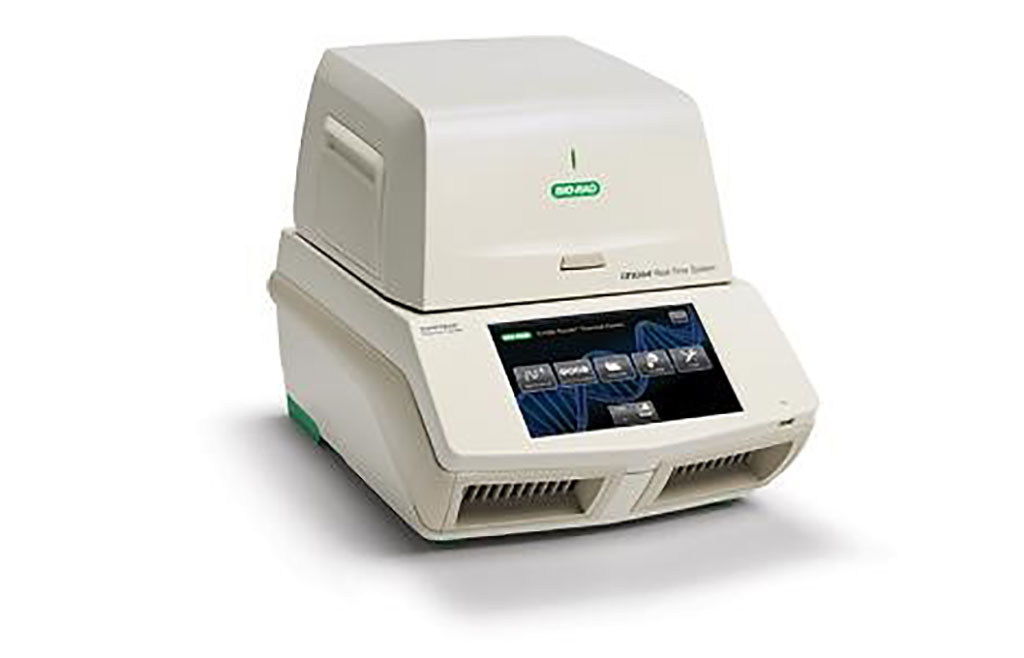Genomic Differences Cause Racial Disparities in Prostate Cancer
|
By LabMedica International staff writers Posted on 17 Jun 2021 |

Image: The CFX384 Touch real-time PCR detection system (Photo courtesy of Bio-Rad)
Prostate cancer is a disease defined by the abnormal growth of cells. These abnormal cells can proliferate in an uncontrolled way and, if left untreated, form tumors which may metastasize or spread to other parts of the body. Prostate cancer (PCa) is the most common solid organ malignancy in men, with 174,650 new diagnoses and 31,620 deaths expected in 2019 in the USA alone.
Effective prognosis and personalized treatment regimens for PCa require identifying tumor-specific genomic factors and events and discovering disease-associated mechanisms. Although previous studies have demonstrated the existence of genomic differences between African-American (AAM) and European-American (EAM) men, the underlying mechanisms driving poor survival in AAM patients are not completely understood.
Urologists at the Icahn School of Medicine at Mount Sinai (New York, NY, USA) and their colleagues analyzed a cohort of 1,152 men, 596 of whom were African American and 556 of whom were European American, and all of whom had undergone radical prostatectomy. Overall, African-American men had higher pre-treatment prostate-specific antigen levels and higher scores indicating increased risk of post-surgery recurrence, emphasizing the more aggressive disease generally found among African-American men.
From post-radical prostatectomy (RP) formalin-fixed paraffin-embedded blocks were submitted for Decipher testing. Submitted tumor tissue included the highest GG with at least 0.5 mm2 of tissue. RNA was extracted using the RNeasy kit (Qiagen, Santa Clara, CA, USA), and cDNA was prepared and amplified using the NuGEN Ovation WTA assay (NuGEN, Redwood City, CA, USA) and hybridized to Human Exon 1.0 ST microarrays (Thermo Fisher Scientific, Carlsbad, CA, USA). Quantitative real-time PCR was analyzed on the CFX384 Touch real-time PCR system (Bio-Rad Laboratories, Hercules, CA, USA).
Comparative analyses between the race groups were conducted at the clinical, genomic, pathway, molecular subtype, and prognostic levels. The EAM group had increased ERG and ETS expression, decreased SPINK1 expression, and basal-like molecular subtypes. After adjusting for confounders, the AAM group was associated with higher expression of CRYBB2, GSTM3, and inflammation genes (IL33, IFNG, CCL4, CD3, ICOSLG), and lower expression of mismatch repair genes (MSH2, MSH6).
At the pathway level, the AAM group had higher expression of genes sets related to the immune response, apoptosis, hypoxia, and reactive oxygen species. EAM group was associated with higher levels of fatty acid metabolism, DNA repair, and WNT/beta-catenin signaling. The authors concluded that their findings suggest that African-American men who undergo radical prostatectomy should be closely monitored following treatment, as they are generally at increased risk for recurrence. The study was published on June 3, 2021 in the journal Communications Biology.
Related Links:
Icahn School of Medicine at Mount Sinai
Qiagen
NuGEN
Thermo Fisher Scientific
Bio-Rad Laboratories
Effective prognosis and personalized treatment regimens for PCa require identifying tumor-specific genomic factors and events and discovering disease-associated mechanisms. Although previous studies have demonstrated the existence of genomic differences between African-American (AAM) and European-American (EAM) men, the underlying mechanisms driving poor survival in AAM patients are not completely understood.
Urologists at the Icahn School of Medicine at Mount Sinai (New York, NY, USA) and their colleagues analyzed a cohort of 1,152 men, 596 of whom were African American and 556 of whom were European American, and all of whom had undergone radical prostatectomy. Overall, African-American men had higher pre-treatment prostate-specific antigen levels and higher scores indicating increased risk of post-surgery recurrence, emphasizing the more aggressive disease generally found among African-American men.
From post-radical prostatectomy (RP) formalin-fixed paraffin-embedded blocks were submitted for Decipher testing. Submitted tumor tissue included the highest GG with at least 0.5 mm2 of tissue. RNA was extracted using the RNeasy kit (Qiagen, Santa Clara, CA, USA), and cDNA was prepared and amplified using the NuGEN Ovation WTA assay (NuGEN, Redwood City, CA, USA) and hybridized to Human Exon 1.0 ST microarrays (Thermo Fisher Scientific, Carlsbad, CA, USA). Quantitative real-time PCR was analyzed on the CFX384 Touch real-time PCR system (Bio-Rad Laboratories, Hercules, CA, USA).
Comparative analyses between the race groups were conducted at the clinical, genomic, pathway, molecular subtype, and prognostic levels. The EAM group had increased ERG and ETS expression, decreased SPINK1 expression, and basal-like molecular subtypes. After adjusting for confounders, the AAM group was associated with higher expression of CRYBB2, GSTM3, and inflammation genes (IL33, IFNG, CCL4, CD3, ICOSLG), and lower expression of mismatch repair genes (MSH2, MSH6).
At the pathway level, the AAM group had higher expression of genes sets related to the immune response, apoptosis, hypoxia, and reactive oxygen species. EAM group was associated with higher levels of fatty acid metabolism, DNA repair, and WNT/beta-catenin signaling. The authors concluded that their findings suggest that African-American men who undergo radical prostatectomy should be closely monitored following treatment, as they are generally at increased risk for recurrence. The study was published on June 3, 2021 in the journal Communications Biology.
Related Links:
Icahn School of Medicine at Mount Sinai
Qiagen
NuGEN
Thermo Fisher Scientific
Bio-Rad Laboratories
Latest Pathology News
- Genetics and AI Improve Diagnosis of Aortic Stenosis
- AI Tool Simultaneously Identifies Genetic Mutations and Disease Type
- Rapid Low-Cost Tests Can Prevent Child Deaths from Contaminated Medicinal Syrups
- Tumor Signals in Saliva and Blood Enable Non-Invasive Monitoring of Head and Neck Cancer
- Common Health Issues Can Influence New Blood Tests for Alzheimer’s Disease
- Blood Test Formula Identifies Chronic Liver Disease Patients with Higher Cancer Risk
- Tunable Cell-Sorting Device Holds Potential for Multiple Biomedical Applications
- AI Tool Outperforms Doctors in Spotting Blood Cell Abnormalities
- AI Tool Rapidly Analyzes Complex Cancer Images for Personalized Treatment
- Diagnostic Technology Performs Rapid Biofluid Analysis Using Single Droplet
- Novel Technology Tracks Hidden Cancer Cells Faster
- AI Tool Improves Breast Cancer Detection
- AI Tool Predicts Treatment Success in Rectal Cancer Patients
- Blood Test and Sputum Analysis Predict Acute COPD Exacerbation
- AI Tool to Transform Skin Cancer Detection with Near-Perfect Accuracy
- Unique Immune Signatures Distinguish Rare Autoimmune Condition from Multiple Sclerosis
Channels
Clinical Chemistry
view channel
Compact Raman Imaging System Detects Subtle Tumor Signals
Accurate cancer diagnosis often depends on labor-intensive tissue staining and expert pathological review, which can delay results and limit access to rapid screening. These conventional methods also make... Read more
Noninvasive Blood-Glucose Monitoring to Replace Finger Pricks for Diabetics
People with diabetes often need to measure their blood glucose multiple times a day, most commonly through finger-prick blood tests or implanted sensors. These methods can be painful, inconvenient, and... Read moreHematology
view channel
MRD Tests Could Predict Survival in Leukemia Patients
Acute myeloid leukemia is an aggressive blood cancer that disrupts normal blood cell production and often relapses even after intensive treatment. Clinicians currently lack early, reliable markers to predict... Read more
Platelet Activity Blood Test in Middle Age Could Identify Early Alzheimer’s Risk
Early detection of Alzheimer’s disease remains one of the biggest unmet needs in neurology, particularly because the biological changes underlying the disorder begin decades before memory symptoms appear.... Read more
Microvesicles Measurement Could Detect Vascular Injury in Sickle Cell Disease Patients
Assessing disease severity in sickle cell disease (SCD) remains challenging, especially when trying to predict hemolysis, vascular injury, and risk of complications such as vaso-occlusive crises.... Read more
ADLM’s New Coagulation Testing Guidance to Improve Care for Patients on Blood Thinners
Direct oral anticoagulants (DOACs) are one of the most common types of blood thinners. Patients take them to prevent a host of complications that could arise from blood clotting, including stroke, deep... Read moreImmunology
view channel
Ultrasensitive Liquid Biopsy Demonstrates Efficacy in Predicting Immunotherapy Response
Immunotherapy has transformed cancer treatment, but only a small proportion of patients experience lasting benefit, with response rates often remaining between 10% and 20%. Clinicians currently lack reliable... Read more
Blood Test Could Identify Colon Cancer Patients to Benefit from NSAIDs
Colon cancer remains a major cause of cancer-related illness, with many patients facing relapse even after surgery and chemotherapy. Up to 40% of people with stage III disease experience recurrence, highlighting... Read moreMicrobiology
view channel
New UTI Diagnosis Method Delivers Antibiotic Resistance Results 24 Hours Earlier
Urinary tract infections affect around 152 million people every year, making them one of the most common bacterial infections worldwide. In routine medical practice, diagnosis often relies on rapid urine... Read more
Breakthroughs in Microbial Analysis to Enhance Disease Prediction
Microorganisms shape human health, ecosystems, and the planet’s climate, yet identifying them and understanding how they are related remains a major scientific challenge. Even with modern DNA sequencing,... Read morePathology
view channel
Genetics and AI Improve Diagnosis of Aortic Stenosis
Aortic stenosis is a progressive narrowing of the aortic valve that restricts blood flow from the heart and can be fatal if left untreated. There are currently no medical therapies that can prevent or... Read more
AI Tool Simultaneously Identifies Genetic Mutations and Disease Type
Interpreting genetic test results remains a major challenge in modern medicine, particularly for rare and complex diseases. While existing tools can indicate whether a genetic mutation is harmful, they... Read more
Rapid Low-Cost Tests Can Prevent Child Deaths from Contaminated Medicinal Syrups
Medicinal syrups contaminated with toxic chemicals have caused the deaths of hundreds of children worldwide, exposing a critical gap in how these products are tested before reaching patients.... Read more
Tumor Signals in Saliva and Blood Enable Non-Invasive Monitoring of Head and Neck Cancer
Head and neck cancers are among the most aggressive malignancies worldwide, with nearly 900,000 new cases diagnosed each year. Monitoring these cancers for recurrence or relapse typically relies on tissue... Read moreTechnology
view channel
AI Predicts Colorectal Cancer Survival Using Clinical and Molecular Features
Colorectal cancer is one of the most common and deadly cancers worldwide, and accurately predicting patient survival remains a major clinical challenge. Traditional prognostic tools often rely on either... Read more
Diagnostic Chip Monitors Chemotherapy Effectiveness for Brain Cancer
Glioblastoma is one of the most aggressive and fatal brain cancers, with most patients surviving less than two years after diagnosis. Treatment is particularly challenging because the tumor infiltrates... Read moreIndustry
view channel
BD and Penn Institute Collaborate to Advance Immunotherapy through Flow Cytometry
BD (Becton, Dickinson and Company, Franklin Lakes, NJ, USA) has entered into a strategic collaboration with the Institute for Immunology and Immune Health (I3H, Philadelphia, PA, USA) at the University... Read more


















